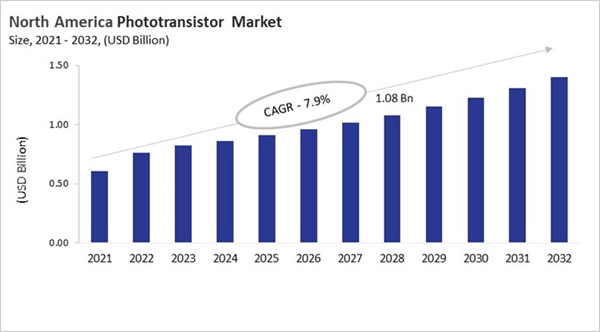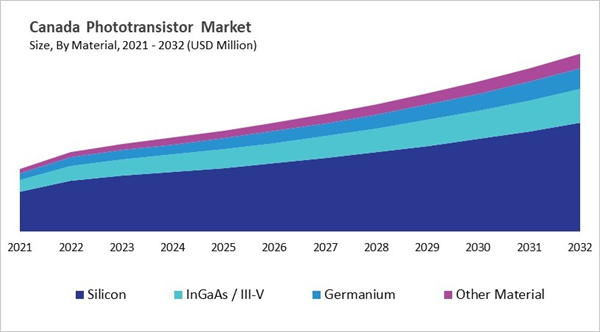The US market dominated the North America Other Wavelength Spectrum Market by country in 2024, and is expected to continue to be a dominant market till 2032; thereby, achieving a market value of $107.1 million by 2032. The Canada market is experiencing a CAGR of 9.2% during 2025-2032. Additionally, the Mexico market is expected to exhibit a CAGR of 8.3% during 2025-2032. The US and Canada led the North America Phototransistor Market by Country with a market share of 71% and 13.8% in 2024.
The phototransistor was first made in the U.S. in 1948 at Bell Labs. The early development was fueled by government spending on telecommunications and defense. In the 1960s, companies like Fairchild and Texas Instruments made silicon phototransistors better for use in space and the military, especially during the Apollo missions. In the 1970s and 1980s, adoption grew to include consumer electronics and industrial automation, thanks to U.S. laws that promoted safety at work. In the 1990s and 2000s, North American companies started to focus more on sectors with high reliability, such as healthcare, aerospace, and automotive. This was because of FDA and federal standards. North America is still a major source of new ideas, especially in the fields of defense, medicine, and smart infrastructure.
Some of the most important trends are the need for aerospace-grade phototransistors for space and defense, healthcare devices that meet strict FDA standards, and smart infrastructure systems that use less energy. Companies in North America put money into federal R&D partnerships, working with medical OEMs to make their products more useful for industrial needs, and building strong regional supply chains. Competition is fierce in markets that require high reliability, and big companies like ON Semiconductor and Osram work in regulated areas. Even though consumer electronics are made in other countries, U.S.-based companies still have a lot of power around the world because they are leaders in design, compliance, and innovation in niche markets.
End-user Outlook
Based on End-user Industry, the market is segmented into Consumer Electronics, Automotive & Transportation, Industrial Automation & Robotics, Aerospace & Defense, Healthcare & Life Sciences, and Other End-user Industry. Among various US Phototransistor Market by End-user Industry; The Consumer Electronics market achieved a market size of USD $191.7 Million in 2024 and is expected to grow at a CAGR of 4.8 % during the forecast period. The Aerospace & Defense market is predicted to experience a CAGR of 6.6% throughout the forecast period from (2025 - 2032).Material Outlook
Based on Material, the market is segmented into Silicon, InGaAs / III-V, Germanium, and Other Material. With a compound annual growth rate (CAGR) of 7.9% over the projection period, the Silicon Market, dominate the Canada Phototransistor Market by Material in 2024 and would be a prominent market until 2032. The Germanium market is expected to witness a CAGR of 9.5% during 2025-2032.Country Outlook
The US is the leader in the North American phototransistor market because it has a strong semiconductor industry, a lot of research and development, and a wide range of end-use sectors. Government policies that encourage making chips in the country and rules that focus on safety and efficiency are making phototransistors popular in cars, consumer electronics, healthcare, and industrial automation. Some trends are the use of multi-sensor modules for IoT, better designs for electric and self-driving cars, and healthcare devices that use less energy. Even though there are imports and other sensors that compete with them, U.S. companies are the best at high-reliability and niche applications. There are still problems like supply chain disruptions and high manufacturing costs, but the U.S. stays in the lead because of new ideas and high demand.List of Key Companies Profiled
- Hamamatsu Photonics K.K.
- Vishay Intertechnology, Inc.
- ams-OSRAM AG
- Rohm Semiconductors Co., Ltd.
- ON Semiconductor Corporation
- Excelitas Technologies Corp.
- Sharp Corporation
- Honeywell International, Inc.
- TT Electronics PLC
- Broadcom, Inc.
Market Report Segmentation
By Type
- Bipolar Junction Phototransistors
- Darlington Phototransistors
- Field-Effect Phototransistors
- Other Type
By End-user Industry
- Consumer Electronics
- Automotive & Transportation
- Industrial Automation & Robotics
- Aerospace & Defense
- Healthcare & Life Sciences
- Other End-user Industry
By Material
- Silicon
- InGaAs / III-V
- Germanium
- Other Material
By Wavelength Spectrum
- Visible
- Near-Infrared (NIR)
- Ultraviolet (UV)
- Other Wavelength Spectrum
By Country
- US
- Canada
- Mexico
- Rest of North America
Table of Contents
Companies Mentioned
- Hamamatsu Photonics K.K.
- Vishay Intertechnology, Inc.
- ams-OSRAM AG
- Rohm Semiconductors Co., Ltd.
- ON Semiconductor Corporation
- Excelitas Technologies Corp.
- Sharp Corporation
- Honeywell International, Inc.
- TT Electronics PLC
- Broadcom, Inc.










